Biology Report: Understanding Meniscal Tears and Rehabilitation
VerifiedAdded on 2022/08/25
|11
|3359
|16
Report
AI Summary
This biology report provides a comprehensive analysis of meniscal tears, a common sports injury. It begins with an introduction emphasizing the importance of joint health and the impact of various sports on different joints and muscles. The report then delves into the role of arthrokinematics and biomechanics in movement and the consequences of joint dysfunction. It explores the anatomy and biomechanics of the knee joint, highlighting the vulnerability of the meniscus to injury. The aetiology of meniscal tears, including both traumatic and degenerative causes, is discussed, along with the diagnostic methods such as physical examination and MRI. The report also covers surgical interventions like arthroscopic meniscus repair and the essential rehabilitation protocols, outlining the goals and phases of recovery to restore knee function. This report provides a detailed overview of meniscal tear injuries, their treatment, and the rehabilitation process.
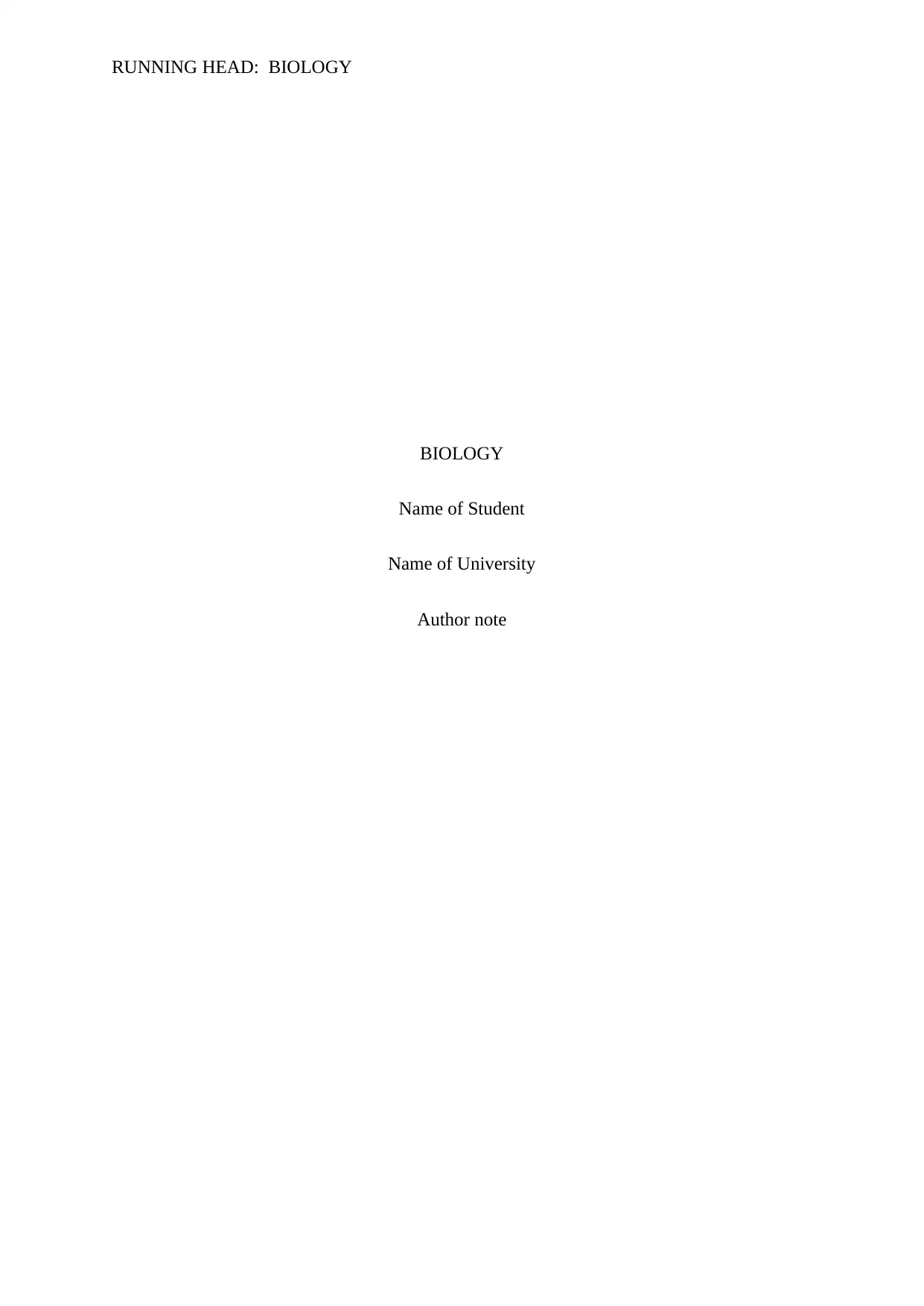
RUNNING HEAD: BIOLOGY
BIOLOGY
Name of Student
Name of University
Author note
BIOLOGY
Name of Student
Name of University
Author note
Paraphrase This Document
Need a fresh take? Get an instant paraphrase of this document with our AI Paraphraser
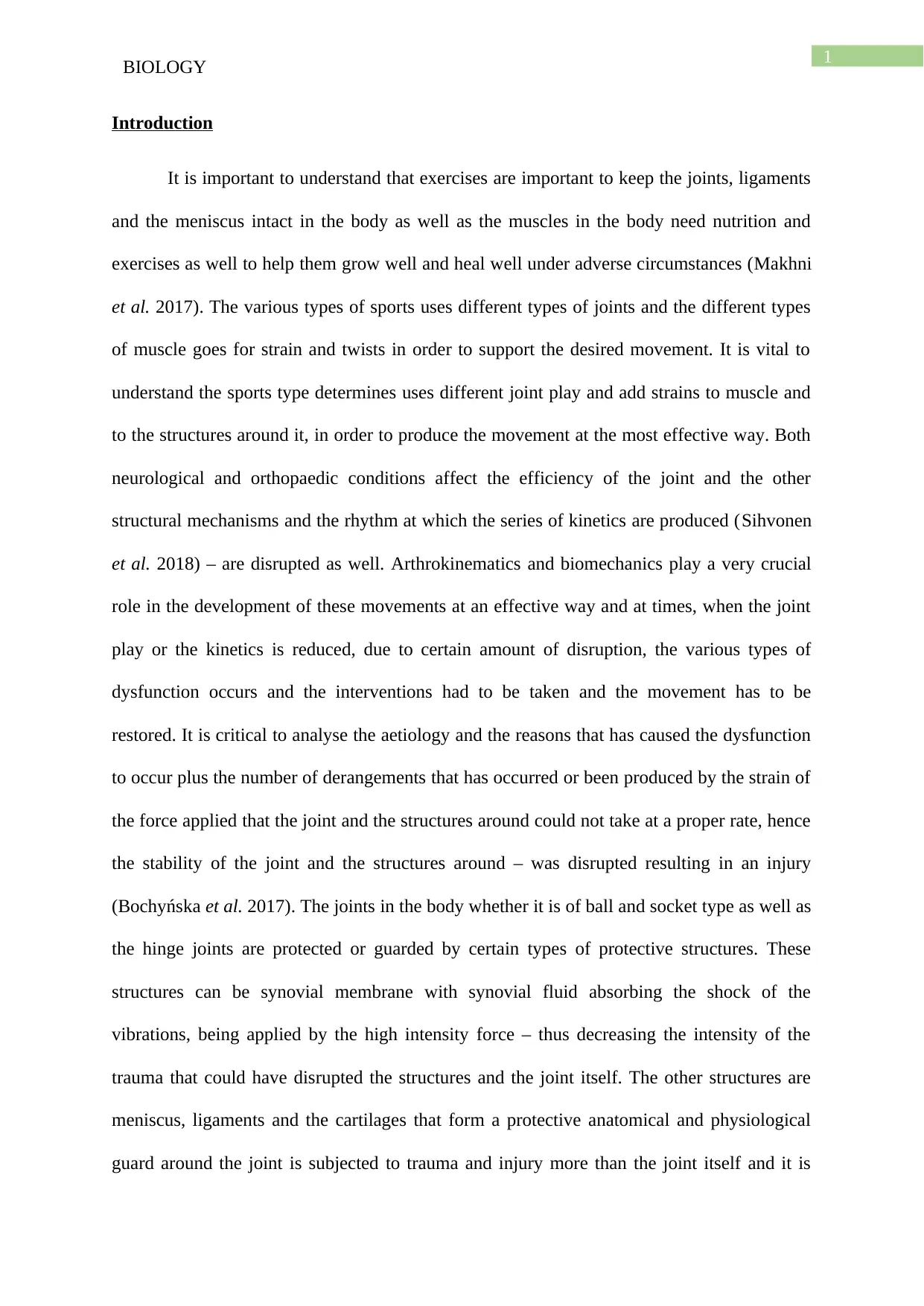
1
BIOLOGY
Introduction
It is important to understand that exercises are important to keep the joints, ligaments
and the meniscus intact in the body as well as the muscles in the body need nutrition and
exercises as well to help them grow well and heal well under adverse circumstances (Makhni
et al. 2017). The various types of sports uses different types of joints and the different types
of muscle goes for strain and twists in order to support the desired movement. It is vital to
understand the sports type determines uses different joint play and add strains to muscle and
to the structures around it, in order to produce the movement at the most effective way. Both
neurological and orthopaedic conditions affect the efficiency of the joint and the other
structural mechanisms and the rhythm at which the series of kinetics are produced (Sihvonen
et al. 2018) – are disrupted as well. Arthrokinematics and biomechanics play a very crucial
role in the development of these movements at an effective way and at times, when the joint
play or the kinetics is reduced, due to certain amount of disruption, the various types of
dysfunction occurs and the interventions had to be taken and the movement has to be
restored. It is critical to analyse the aetiology and the reasons that has caused the dysfunction
to occur plus the number of derangements that has occurred or been produced by the strain of
the force applied that the joint and the structures around could not take at a proper rate, hence
the stability of the joint and the structures around – was disrupted resulting in an injury
(Bochyńska et al. 2017). The joints in the body whether it is of ball and socket type as well as
the hinge joints are protected or guarded by certain types of protective structures. These
structures can be synovial membrane with synovial fluid absorbing the shock of the
vibrations, being applied by the high intensity force – thus decreasing the intensity of the
trauma that could have disrupted the structures and the joint itself. The other structures are
meniscus, ligaments and the cartilages that form a protective anatomical and physiological
guard around the joint is subjected to trauma and injury more than the joint itself and it is
BIOLOGY
Introduction
It is important to understand that exercises are important to keep the joints, ligaments
and the meniscus intact in the body as well as the muscles in the body need nutrition and
exercises as well to help them grow well and heal well under adverse circumstances (Makhni
et al. 2017). The various types of sports uses different types of joints and the different types
of muscle goes for strain and twists in order to support the desired movement. It is vital to
understand the sports type determines uses different joint play and add strains to muscle and
to the structures around it, in order to produce the movement at the most effective way. Both
neurological and orthopaedic conditions affect the efficiency of the joint and the other
structural mechanisms and the rhythm at which the series of kinetics are produced (Sihvonen
et al. 2018) – are disrupted as well. Arthrokinematics and biomechanics play a very crucial
role in the development of these movements at an effective way and at times, when the joint
play or the kinetics is reduced, due to certain amount of disruption, the various types of
dysfunction occurs and the interventions had to be taken and the movement has to be
restored. It is critical to analyse the aetiology and the reasons that has caused the dysfunction
to occur plus the number of derangements that has occurred or been produced by the strain of
the force applied that the joint and the structures around could not take at a proper rate, hence
the stability of the joint and the structures around – was disrupted resulting in an injury
(Bochyńska et al. 2017). The joints in the body whether it is of ball and socket type as well as
the hinge joints are protected or guarded by certain types of protective structures. These
structures can be synovial membrane with synovial fluid absorbing the shock of the
vibrations, being applied by the high intensity force – thus decreasing the intensity of the
trauma that could have disrupted the structures and the joint itself. The other structures are
meniscus, ligaments and the cartilages that form a protective anatomical and physiological
guard around the joint is subjected to trauma and injury more than the joint itself and it is
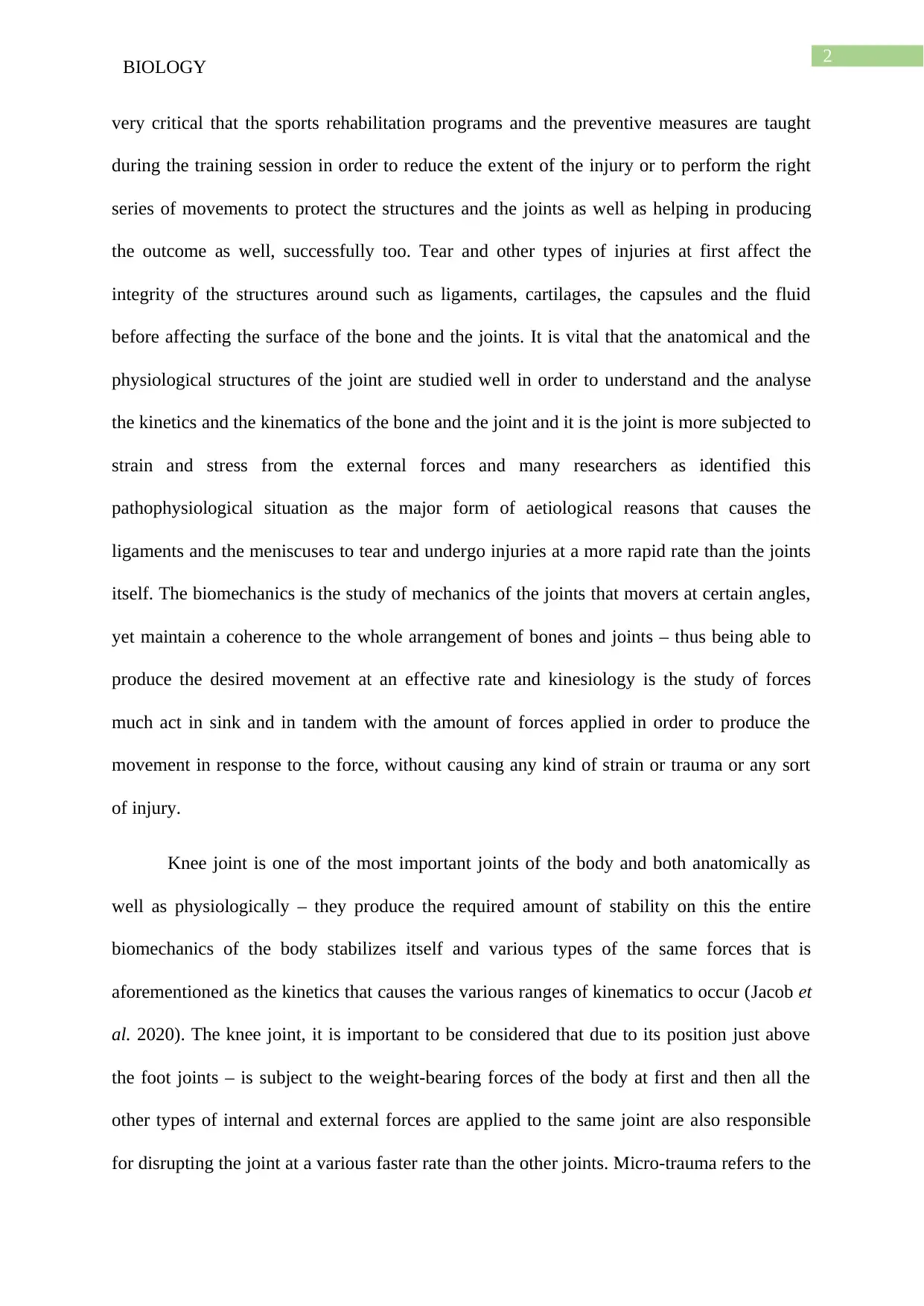
2
BIOLOGY
very critical that the sports rehabilitation programs and the preventive measures are taught
during the training session in order to reduce the extent of the injury or to perform the right
series of movements to protect the structures and the joints as well as helping in producing
the outcome as well, successfully too. Tear and other types of injuries at first affect the
integrity of the structures around such as ligaments, cartilages, the capsules and the fluid
before affecting the surface of the bone and the joints. It is vital that the anatomical and the
physiological structures of the joint are studied well in order to understand and the analyse
the kinetics and the kinematics of the bone and the joint and it is the joint is more subjected to
strain and stress from the external forces and many researchers as identified this
pathophysiological situation as the major form of aetiological reasons that causes the
ligaments and the meniscuses to tear and undergo injuries at a more rapid rate than the joints
itself. The biomechanics is the study of mechanics of the joints that movers at certain angles,
yet maintain a coherence to the whole arrangement of bones and joints – thus being able to
produce the desired movement at an effective rate and kinesiology is the study of forces
much act in sink and in tandem with the amount of forces applied in order to produce the
movement in response to the force, without causing any kind of strain or trauma or any sort
of injury.
Knee joint is one of the most important joints of the body and both anatomically as
well as physiologically – they produce the required amount of stability on this the entire
biomechanics of the body stabilizes itself and various types of the same forces that is
aforementioned as the kinetics that causes the various ranges of kinematics to occur (Jacob et
al. 2020). The knee joint, it is important to be considered that due to its position just above
the foot joints – is subject to the weight-bearing forces of the body at first and then all the
other types of internal and external forces are applied to the same joint are also responsible
for disrupting the joint at a various faster rate than the other joints. Micro-trauma refers to the
BIOLOGY
very critical that the sports rehabilitation programs and the preventive measures are taught
during the training session in order to reduce the extent of the injury or to perform the right
series of movements to protect the structures and the joints as well as helping in producing
the outcome as well, successfully too. Tear and other types of injuries at first affect the
integrity of the structures around such as ligaments, cartilages, the capsules and the fluid
before affecting the surface of the bone and the joints. It is vital that the anatomical and the
physiological structures of the joint are studied well in order to understand and the analyse
the kinetics and the kinematics of the bone and the joint and it is the joint is more subjected to
strain and stress from the external forces and many researchers as identified this
pathophysiological situation as the major form of aetiological reasons that causes the
ligaments and the meniscuses to tear and undergo injuries at a more rapid rate than the joints
itself. The biomechanics is the study of mechanics of the joints that movers at certain angles,
yet maintain a coherence to the whole arrangement of bones and joints – thus being able to
produce the desired movement at an effective rate and kinesiology is the study of forces
much act in sink and in tandem with the amount of forces applied in order to produce the
movement in response to the force, without causing any kind of strain or trauma or any sort
of injury.
Knee joint is one of the most important joints of the body and both anatomically as
well as physiologically – they produce the required amount of stability on this the entire
biomechanics of the body stabilizes itself and various types of the same forces that is
aforementioned as the kinetics that causes the various ranges of kinematics to occur (Jacob et
al. 2020). The knee joint, it is important to be considered that due to its position just above
the foot joints – is subject to the weight-bearing forces of the body at first and then all the
other types of internal and external forces are applied to the same joint are also responsible
for disrupting the joint at a various faster rate than the other joints. Micro-trauma refers to the
⊘ This is a preview!⊘
Do you want full access?
Subscribe today to unlock all pages.

Trusted by 1+ million students worldwide
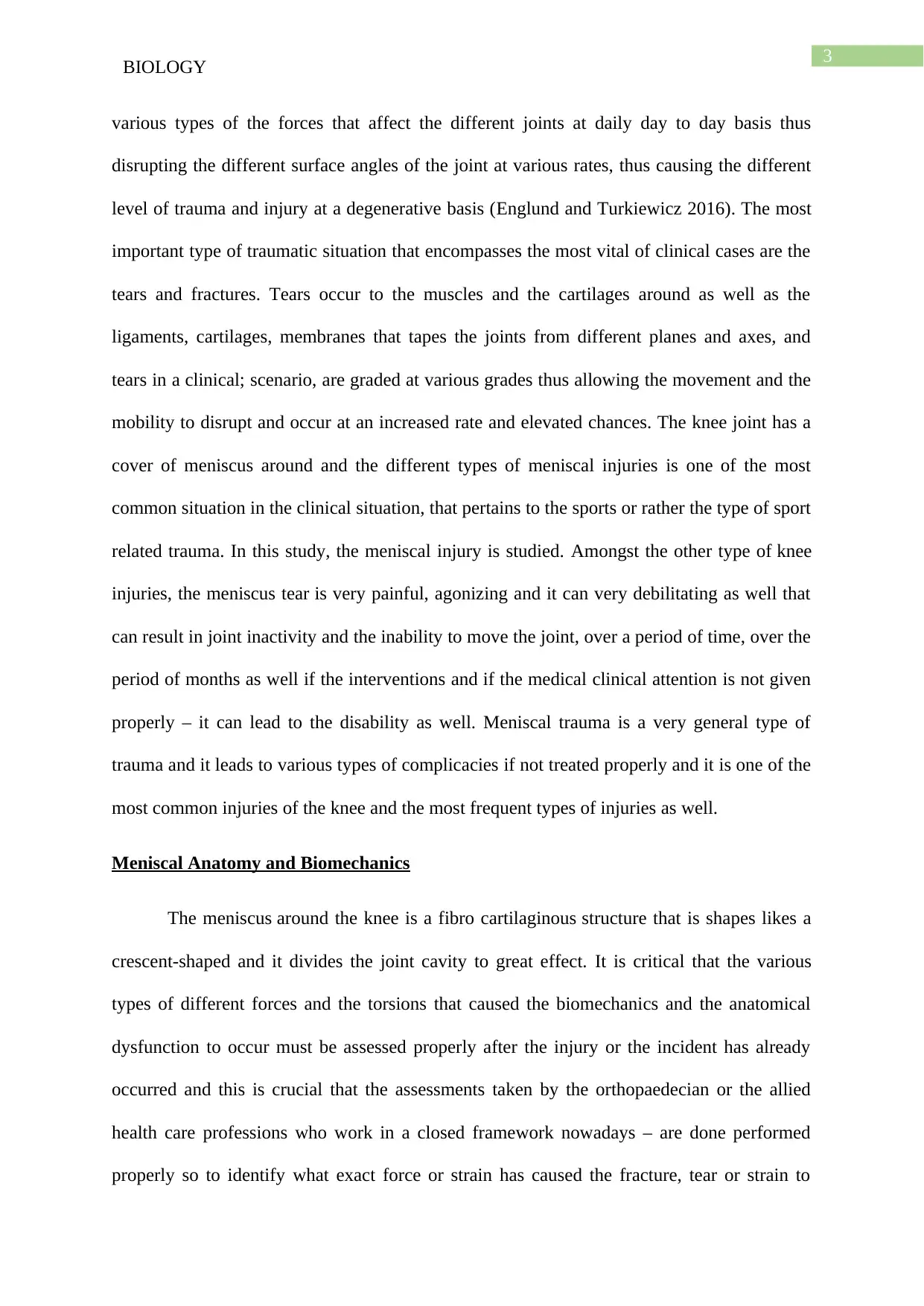
3
BIOLOGY
various types of the forces that affect the different joints at daily day to day basis thus
disrupting the different surface angles of the joint at various rates, thus causing the different
level of trauma and injury at a degenerative basis (Englund and Turkiewicz 2016). The most
important type of traumatic situation that encompasses the most vital of clinical cases are the
tears and fractures. Tears occur to the muscles and the cartilages around as well as the
ligaments, cartilages, membranes that tapes the joints from different planes and axes, and
tears in a clinical; scenario, are graded at various grades thus allowing the movement and the
mobility to disrupt and occur at an increased rate and elevated chances. The knee joint has a
cover of meniscus around and the different types of meniscal injuries is one of the most
common situation in the clinical situation, that pertains to the sports or rather the type of sport
related trauma. In this study, the meniscal injury is studied. Amongst the other type of knee
injuries, the meniscus tear is very painful, agonizing and it can very debilitating as well that
can result in joint inactivity and the inability to move the joint, over a period of time, over the
period of months as well if the interventions and if the medical clinical attention is not given
properly – it can lead to the disability as well. Meniscal trauma is a very general type of
trauma and it leads to various types of complicacies if not treated properly and it is one of the
most common injuries of the knee and the most frequent types of injuries as well.
Meniscal Anatomy and Biomechanics
The meniscus around the knee is a fibro cartilaginous structure that is shapes likes a
crescent-shaped and it divides the joint cavity to great effect. It is critical that the various
types of different forces and the torsions that caused the biomechanics and the anatomical
dysfunction to occur must be assessed properly after the injury or the incident has already
occurred and this is crucial that the assessments taken by the orthopaedecian or the allied
health care professions who work in a closed framework nowadays – are done performed
properly so to identify what exact force or strain has caused the fracture, tear or strain to
BIOLOGY
various types of the forces that affect the different joints at daily day to day basis thus
disrupting the different surface angles of the joint at various rates, thus causing the different
level of trauma and injury at a degenerative basis (Englund and Turkiewicz 2016). The most
important type of traumatic situation that encompasses the most vital of clinical cases are the
tears and fractures. Tears occur to the muscles and the cartilages around as well as the
ligaments, cartilages, membranes that tapes the joints from different planes and axes, and
tears in a clinical; scenario, are graded at various grades thus allowing the movement and the
mobility to disrupt and occur at an increased rate and elevated chances. The knee joint has a
cover of meniscus around and the different types of meniscal injuries is one of the most
common situation in the clinical situation, that pertains to the sports or rather the type of sport
related trauma. In this study, the meniscal injury is studied. Amongst the other type of knee
injuries, the meniscus tear is very painful, agonizing and it can very debilitating as well that
can result in joint inactivity and the inability to move the joint, over a period of time, over the
period of months as well if the interventions and if the medical clinical attention is not given
properly – it can lead to the disability as well. Meniscal trauma is a very general type of
trauma and it leads to various types of complicacies if not treated properly and it is one of the
most common injuries of the knee and the most frequent types of injuries as well.
Meniscal Anatomy and Biomechanics
The meniscus around the knee is a fibro cartilaginous structure that is shapes likes a
crescent-shaped and it divides the joint cavity to great effect. It is critical that the various
types of different forces and the torsions that caused the biomechanics and the anatomical
dysfunction to occur must be assessed properly after the injury or the incident has already
occurred and this is crucial that the assessments taken by the orthopaedecian or the allied
health care professions who work in a closed framework nowadays – are done performed
properly so to identify what exact force or strain has caused the fracture, tear or strain to
Paraphrase This Document
Need a fresh take? Get an instant paraphrase of this document with our AI Paraphraser
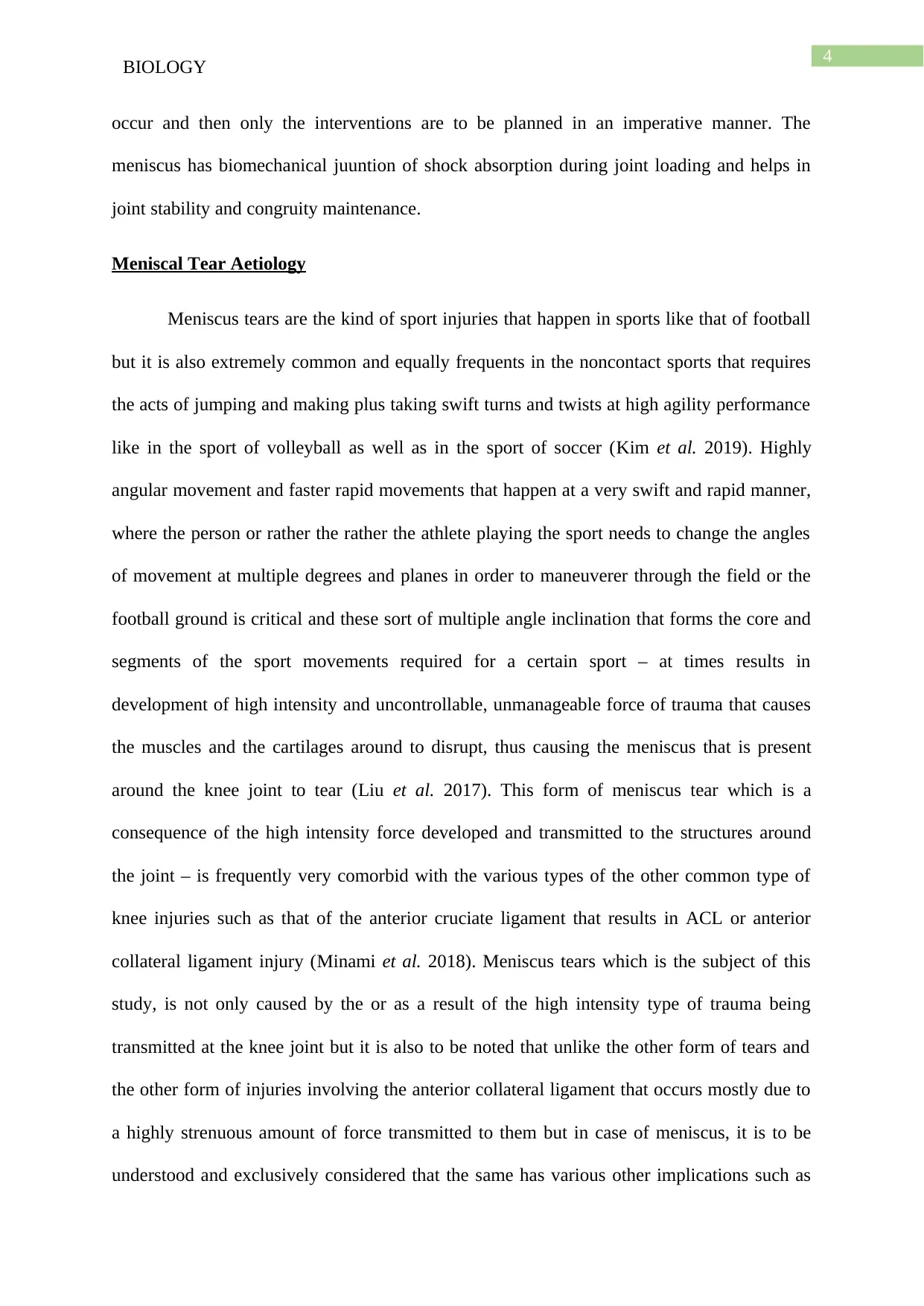
4
BIOLOGY
occur and then only the interventions are to be planned in an imperative manner. The
meniscus has biomechanical juuntion of shock absorption during joint loading and helps in
joint stability and congruity maintenance.
Meniscal Tear Aetiology
Meniscus tears are the kind of sport injuries that happen in sports like that of football
but it is also extremely common and equally frequents in the noncontact sports that requires
the acts of jumping and making plus taking swift turns and twists at high agility performance
like in the sport of volleyball as well as in the sport of soccer (Kim et al. 2019). Highly
angular movement and faster rapid movements that happen at a very swift and rapid manner,
where the person or rather the rather the athlete playing the sport needs to change the angles
of movement at multiple degrees and planes in order to maneuverer through the field or the
football ground is critical and these sort of multiple angle inclination that forms the core and
segments of the sport movements required for a certain sport – at times results in
development of high intensity and uncontrollable, unmanageable force of trauma that causes
the muscles and the cartilages around to disrupt, thus causing the meniscus that is present
around the knee joint to tear (Liu et al. 2017). This form of meniscus tear which is a
consequence of the high intensity force developed and transmitted to the structures around
the joint – is frequently very comorbid with the various types of the other common type of
knee injuries such as that of the anterior cruciate ligament that results in ACL or anterior
collateral ligament injury (Minami et al. 2018). Meniscus tears which is the subject of this
study, is not only caused by the or as a result of the high intensity type of trauma being
transmitted at the knee joint but it is also to be noted that unlike the other form of tears and
the other form of injuries involving the anterior collateral ligament that occurs mostly due to
a highly strenuous amount of force transmitted to them but in case of meniscus, it is to be
understood and exclusively considered that the same has various other implications such as
BIOLOGY
occur and then only the interventions are to be planned in an imperative manner. The
meniscus has biomechanical juuntion of shock absorption during joint loading and helps in
joint stability and congruity maintenance.
Meniscal Tear Aetiology
Meniscus tears are the kind of sport injuries that happen in sports like that of football
but it is also extremely common and equally frequents in the noncontact sports that requires
the acts of jumping and making plus taking swift turns and twists at high agility performance
like in the sport of volleyball as well as in the sport of soccer (Kim et al. 2019). Highly
angular movement and faster rapid movements that happen at a very swift and rapid manner,
where the person or rather the rather the athlete playing the sport needs to change the angles
of movement at multiple degrees and planes in order to maneuverer through the field or the
football ground is critical and these sort of multiple angle inclination that forms the core and
segments of the sport movements required for a certain sport – at times results in
development of high intensity and uncontrollable, unmanageable force of trauma that causes
the muscles and the cartilages around to disrupt, thus causing the meniscus that is present
around the knee joint to tear (Liu et al. 2017). This form of meniscus tear which is a
consequence of the high intensity force developed and transmitted to the structures around
the joint – is frequently very comorbid with the various types of the other common type of
knee injuries such as that of the anterior cruciate ligament that results in ACL or anterior
collateral ligament injury (Minami et al. 2018). Meniscus tears which is the subject of this
study, is not only caused by the or as a result of the high intensity type of trauma being
transmitted at the knee joint but it is also to be noted that unlike the other form of tears and
the other form of injuries involving the anterior collateral ligament that occurs mostly due to
a highly strenuous amount of force transmitted to them but in case of meniscus, it is to be
understood and exclusively considered that the same has various other implications such as
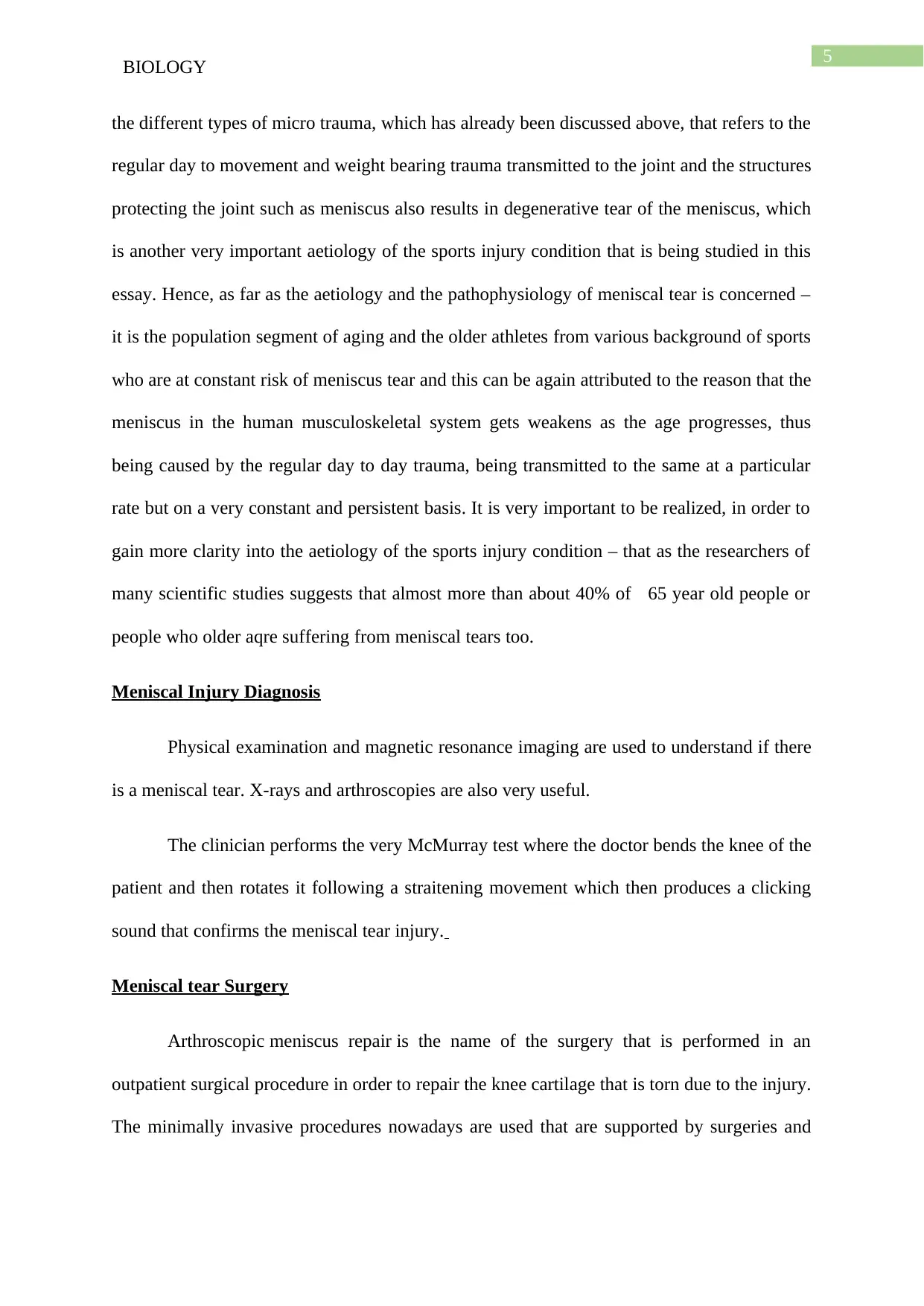
5
BIOLOGY
the different types of micro trauma, which has already been discussed above, that refers to the
regular day to movement and weight bearing trauma transmitted to the joint and the structures
protecting the joint such as meniscus also results in degenerative tear of the meniscus, which
is another very important aetiology of the sports injury condition that is being studied in this
essay. Hence, as far as the aetiology and the pathophysiology of meniscal tear is concerned –
it is the population segment of aging and the older athletes from various background of sports
who are at constant risk of meniscus tear and this can be again attributed to the reason that the
meniscus in the human musculoskeletal system gets weakens as the age progresses, thus
being caused by the regular day to day trauma, being transmitted to the same at a particular
rate but on a very constant and persistent basis. It is very important to be realized, in order to
gain more clarity into the aetiology of the sports injury condition – that as the researchers of
many scientific studies suggests that almost more than about 40% of 65 year old people or
people who older aqre suffering from meniscal tears too.
Meniscal Injury Diagnosis
Physical examination and magnetic resonance imaging are used to understand if there
is a meniscal tear. X-rays and arthroscopies are also very useful.
The clinician performs the very McMurray test where the doctor bends the knee of the
patient and then rotates it following a straitening movement which then produces a clicking
sound that confirms the meniscal tear injury.
Meniscal tear Surgery
Arthroscopic meniscus repair is the name of the surgery that is performed in an
outpatient surgical procedure in order to repair the knee cartilage that is torn due to the injury.
The minimally invasive procedures nowadays are used that are supported by surgeries and
BIOLOGY
the different types of micro trauma, which has already been discussed above, that refers to the
regular day to movement and weight bearing trauma transmitted to the joint and the structures
protecting the joint such as meniscus also results in degenerative tear of the meniscus, which
is another very important aetiology of the sports injury condition that is being studied in this
essay. Hence, as far as the aetiology and the pathophysiology of meniscal tear is concerned –
it is the population segment of aging and the older athletes from various background of sports
who are at constant risk of meniscus tear and this can be again attributed to the reason that the
meniscus in the human musculoskeletal system gets weakens as the age progresses, thus
being caused by the regular day to day trauma, being transmitted to the same at a particular
rate but on a very constant and persistent basis. It is very important to be realized, in order to
gain more clarity into the aetiology of the sports injury condition – that as the researchers of
many scientific studies suggests that almost more than about 40% of 65 year old people or
people who older aqre suffering from meniscal tears too.
Meniscal Injury Diagnosis
Physical examination and magnetic resonance imaging are used to understand if there
is a meniscal tear. X-rays and arthroscopies are also very useful.
The clinician performs the very McMurray test where the doctor bends the knee of the
patient and then rotates it following a straitening movement which then produces a clicking
sound that confirms the meniscal tear injury.
Meniscal tear Surgery
Arthroscopic meniscus repair is the name of the surgery that is performed in an
outpatient surgical procedure in order to repair the knee cartilage that is torn due to the injury.
The minimally invasive procedures nowadays are used that are supported by surgeries and
⊘ This is a preview!⊘
Do you want full access?
Subscribe today to unlock all pages.

Trusted by 1+ million students worldwide
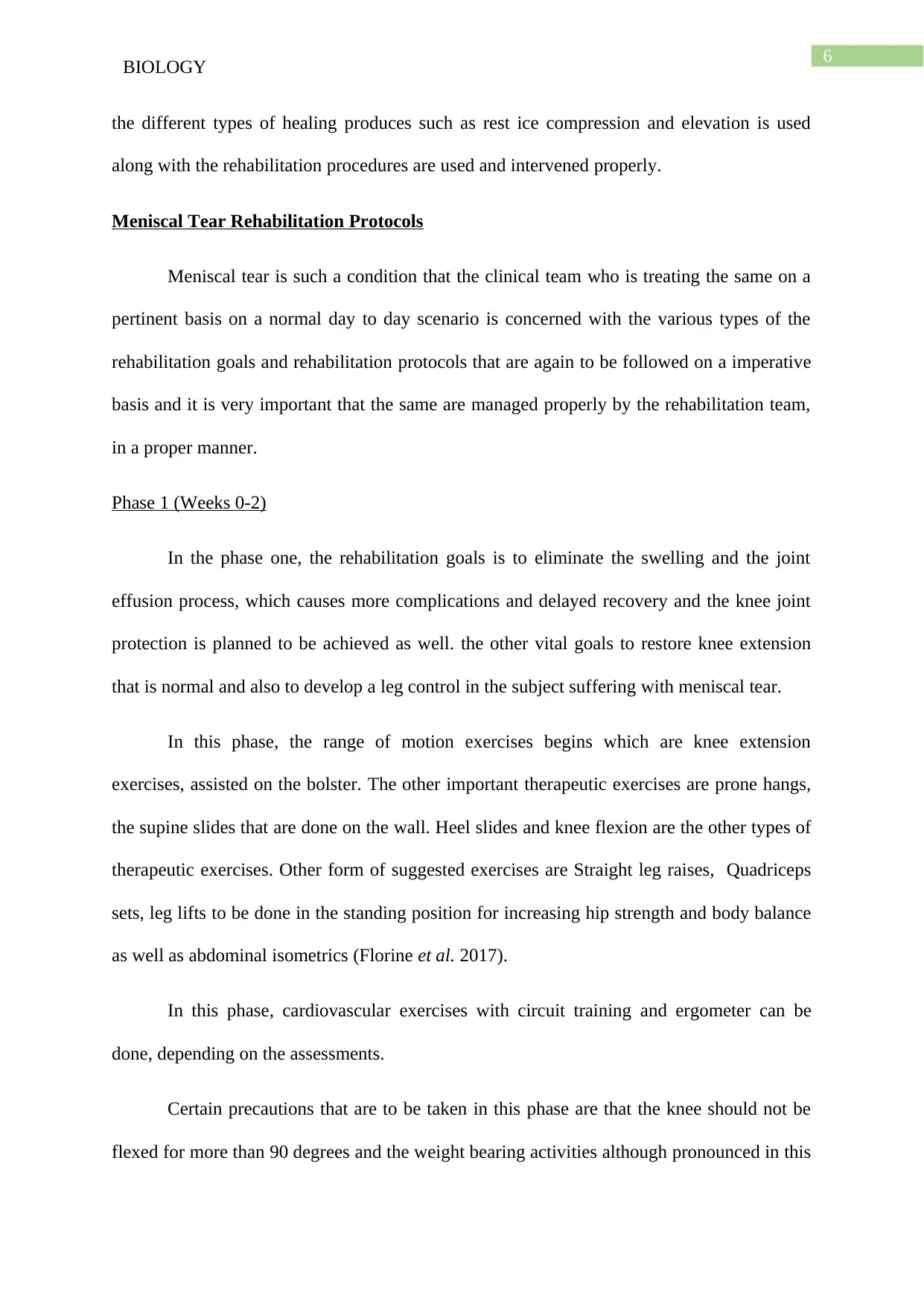
6
BIOLOGY
the different types of healing produces such as rest ice compression and elevation is used
along with the rehabilitation procedures are used and intervened properly.
Meniscal Tear Rehabilitation Protocols
Meniscal tear is such a condition that the clinical team who is treating the same on a
pertinent basis on a normal day to day scenario is concerned with the various types of the
rehabilitation goals and rehabilitation protocols that are again to be followed on a imperative
basis and it is very important that the same are managed properly by the rehabilitation team,
in a proper manner.
Phase 1 (Weeks 0-2)
In the phase one, the rehabilitation goals is to eliminate the swelling and the joint
effusion process, which causes more complications and delayed recovery and the knee joint
protection is planned to be achieved as well. the other vital goals to restore knee extension
that is normal and also to develop a leg control in the subject suffering with meniscal tear.
In this phase, the range of motion exercises begins which are knee extension
exercises, assisted on the bolster. The other important therapeutic exercises are prone hangs,
the supine slides that are done on the wall. Heel slides and knee flexion are the other types of
therapeutic exercises. Other form of suggested exercises are Straight leg raises, Quadriceps
sets, leg lifts to be done in the standing position for increasing hip strength and body balance
as well as abdominal isometrics (Florine et al. 2017).
In this phase, cardiovascular exercises with circuit training and ergometer can be
done, depending on the assessments.
Certain precautions that are to be taken in this phase are that the knee should not be
flexed for more than 90 degrees and the weight bearing activities although pronounced in this
BIOLOGY
the different types of healing produces such as rest ice compression and elevation is used
along with the rehabilitation procedures are used and intervened properly.
Meniscal Tear Rehabilitation Protocols
Meniscal tear is such a condition that the clinical team who is treating the same on a
pertinent basis on a normal day to day scenario is concerned with the various types of the
rehabilitation goals and rehabilitation protocols that are again to be followed on a imperative
basis and it is very important that the same are managed properly by the rehabilitation team,
in a proper manner.
Phase 1 (Weeks 0-2)
In the phase one, the rehabilitation goals is to eliminate the swelling and the joint
effusion process, which causes more complications and delayed recovery and the knee joint
protection is planned to be achieved as well. the other vital goals to restore knee extension
that is normal and also to develop a leg control in the subject suffering with meniscal tear.
In this phase, the range of motion exercises begins which are knee extension
exercises, assisted on the bolster. The other important therapeutic exercises are prone hangs,
the supine slides that are done on the wall. Heel slides and knee flexion are the other types of
therapeutic exercises. Other form of suggested exercises are Straight leg raises, Quadriceps
sets, leg lifts to be done in the standing position for increasing hip strength and body balance
as well as abdominal isometrics (Florine et al. 2017).
In this phase, cardiovascular exercises with circuit training and ergometer can be
done, depending on the assessments.
Certain precautions that are to be taken in this phase are that the knee should not be
flexed for more than 90 degrees and the weight bearing activities although pronounced in this
Paraphrase This Document
Need a fresh take? Get an instant paraphrase of this document with our AI Paraphraser
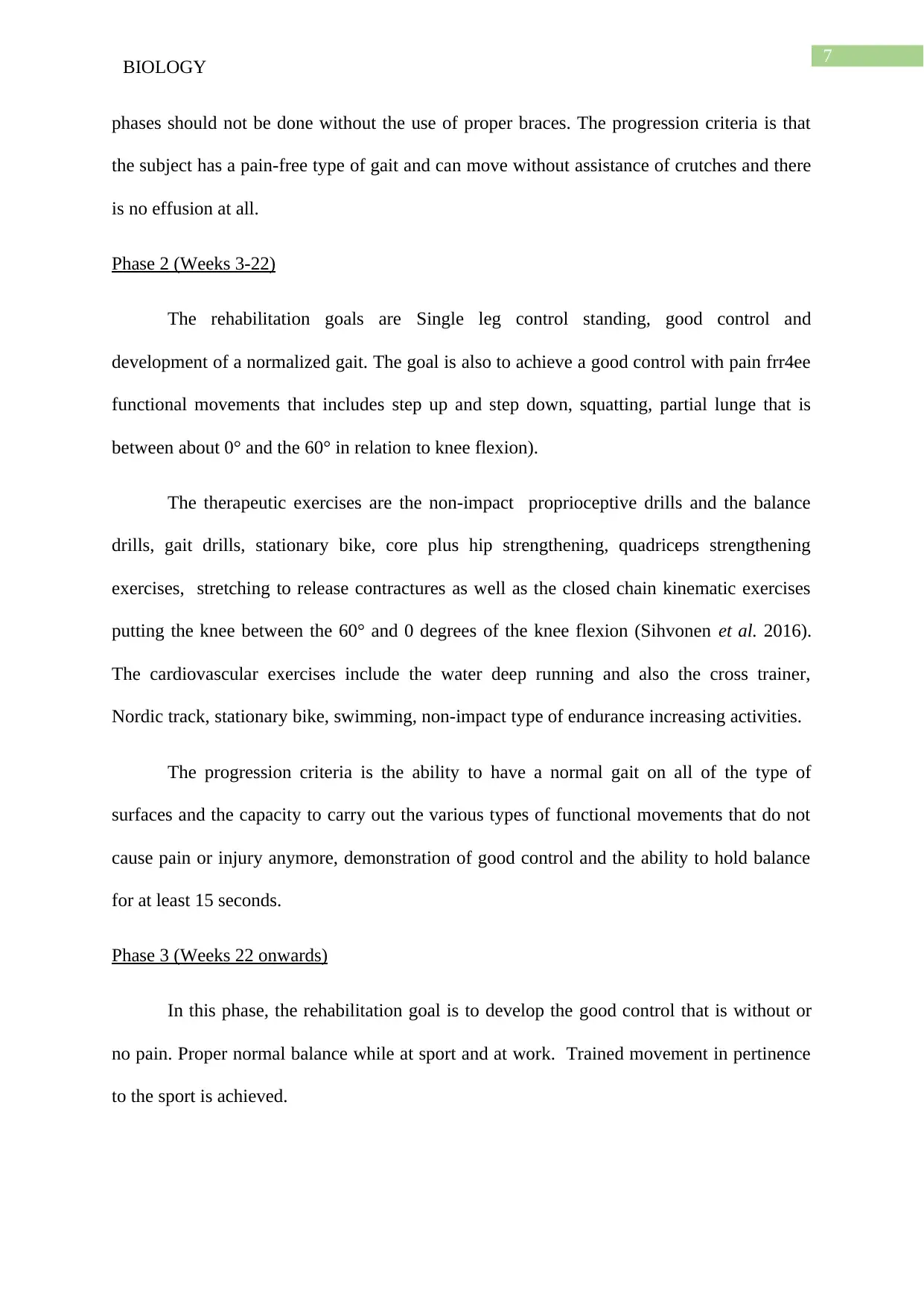
7
BIOLOGY
phases should not be done without the use of proper braces. The progression criteria is that
the subject has a pain-free type of gait and can move without assistance of crutches and there
is no effusion at all.
Phase 2 (Weeks 3-22)
The rehabilitation goals are Single leg control standing, good control and
development of a normalized gait. The goal is also to achieve a good control with pain frr4ee
functional movements that includes step up and step down, squatting, partial lunge that is
between about 0° and the 60° in relation to knee flexion).
The therapeutic exercises are the non-impact proprioceptive drills and the balance
drills, gait drills, stationary bike, core plus hip strengthening, quadriceps strengthening
exercises, stretching to release contractures as well as the closed chain kinematic exercises
putting the knee between the 60° and 0 degrees of the knee flexion (Sihvonen et al. 2016).
The cardiovascular exercises include the water deep running and also the cross trainer,
Nordic track, stationary bike, swimming, non-impact type of endurance increasing activities.
The progression criteria is the ability to have a normal gait on all of the type of
surfaces and the capacity to carry out the various types of functional movements that do not
cause pain or injury anymore, demonstration of good control and the ability to hold balance
for at least 15 seconds.
Phase 3 (Weeks 22 onwards)
In this phase, the rehabilitation goal is to develop the good control that is without or
no pain. Proper normal balance while at sport and at work. Trained movement in pertinence
to the sport is achieved.
BIOLOGY
phases should not be done without the use of proper braces. The progression criteria is that
the subject has a pain-free type of gait and can move without assistance of crutches and there
is no effusion at all.
Phase 2 (Weeks 3-22)
The rehabilitation goals are Single leg control standing, good control and
development of a normalized gait. The goal is also to achieve a good control with pain frr4ee
functional movements that includes step up and step down, squatting, partial lunge that is
between about 0° and the 60° in relation to knee flexion).
The therapeutic exercises are the non-impact proprioceptive drills and the balance
drills, gait drills, stationary bike, core plus hip strengthening, quadriceps strengthening
exercises, stretching to release contractures as well as the closed chain kinematic exercises
putting the knee between the 60° and 0 degrees of the knee flexion (Sihvonen et al. 2016).
The cardiovascular exercises include the water deep running and also the cross trainer,
Nordic track, stationary bike, swimming, non-impact type of endurance increasing activities.
The progression criteria is the ability to have a normal gait on all of the type of
surfaces and the capacity to carry out the various types of functional movements that do not
cause pain or injury anymore, demonstration of good control and the ability to hold balance
for at least 15 seconds.
Phase 3 (Weeks 22 onwards)
In this phase, the rehabilitation goal is to develop the good control that is without or
no pain. Proper normal balance while at sport and at work. Trained movement in pertinence
to the sport is achieved.
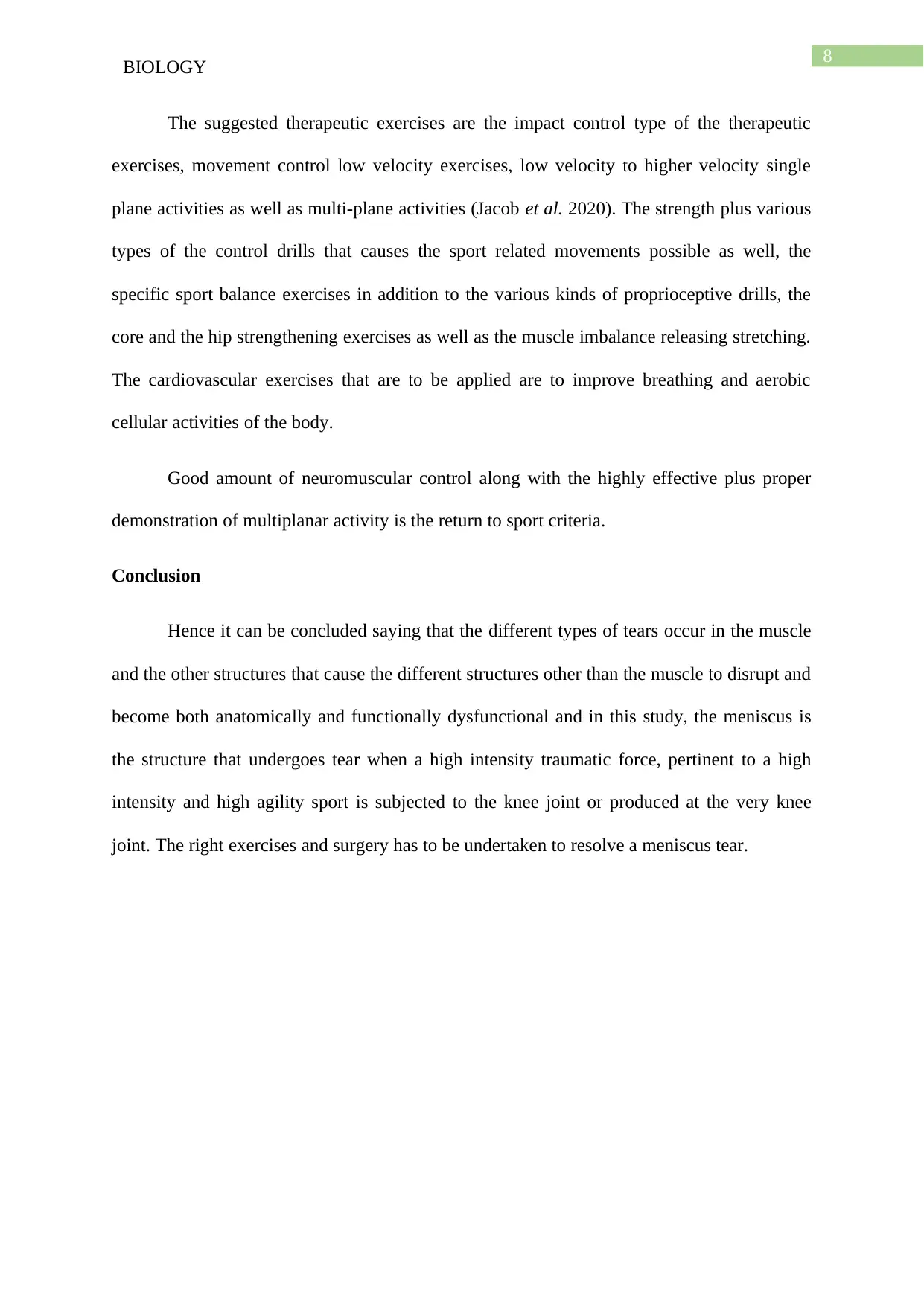
8
BIOLOGY
The suggested therapeutic exercises are the impact control type of the therapeutic
exercises, movement control low velocity exercises, low velocity to higher velocity single
plane activities as well as multi-plane activities (Jacob et al. 2020). The strength plus various
types of the control drills that causes the sport related movements possible as well, the
specific sport balance exercises in addition to the various kinds of proprioceptive drills, the
core and the hip strengthening exercises as well as the muscle imbalance releasing stretching.
The cardiovascular exercises that are to be applied are to improve breathing and aerobic
cellular activities of the body.
Good amount of neuromuscular control along with the highly effective plus proper
demonstration of multiplanar activity is the return to sport criteria.
Conclusion
Hence it can be concluded saying that the different types of tears occur in the muscle
and the other structures that cause the different structures other than the muscle to disrupt and
become both anatomically and functionally dysfunctional and in this study, the meniscus is
the structure that undergoes tear when a high intensity traumatic force, pertinent to a high
intensity and high agility sport is subjected to the knee joint or produced at the very knee
joint. The right exercises and surgery has to be undertaken to resolve a meniscus tear.
BIOLOGY
The suggested therapeutic exercises are the impact control type of the therapeutic
exercises, movement control low velocity exercises, low velocity to higher velocity single
plane activities as well as multi-plane activities (Jacob et al. 2020). The strength plus various
types of the control drills that causes the sport related movements possible as well, the
specific sport balance exercises in addition to the various kinds of proprioceptive drills, the
core and the hip strengthening exercises as well as the muscle imbalance releasing stretching.
The cardiovascular exercises that are to be applied are to improve breathing and aerobic
cellular activities of the body.
Good amount of neuromuscular control along with the highly effective plus proper
demonstration of multiplanar activity is the return to sport criteria.
Conclusion
Hence it can be concluded saying that the different types of tears occur in the muscle
and the other structures that cause the different structures other than the muscle to disrupt and
become both anatomically and functionally dysfunctional and in this study, the meniscus is
the structure that undergoes tear when a high intensity traumatic force, pertinent to a high
intensity and high agility sport is subjected to the knee joint or produced at the very knee
joint. The right exercises and surgery has to be undertaken to resolve a meniscus tear.
⊘ This is a preview!⊘
Do you want full access?
Subscribe today to unlock all pages.

Trusted by 1+ million students worldwide
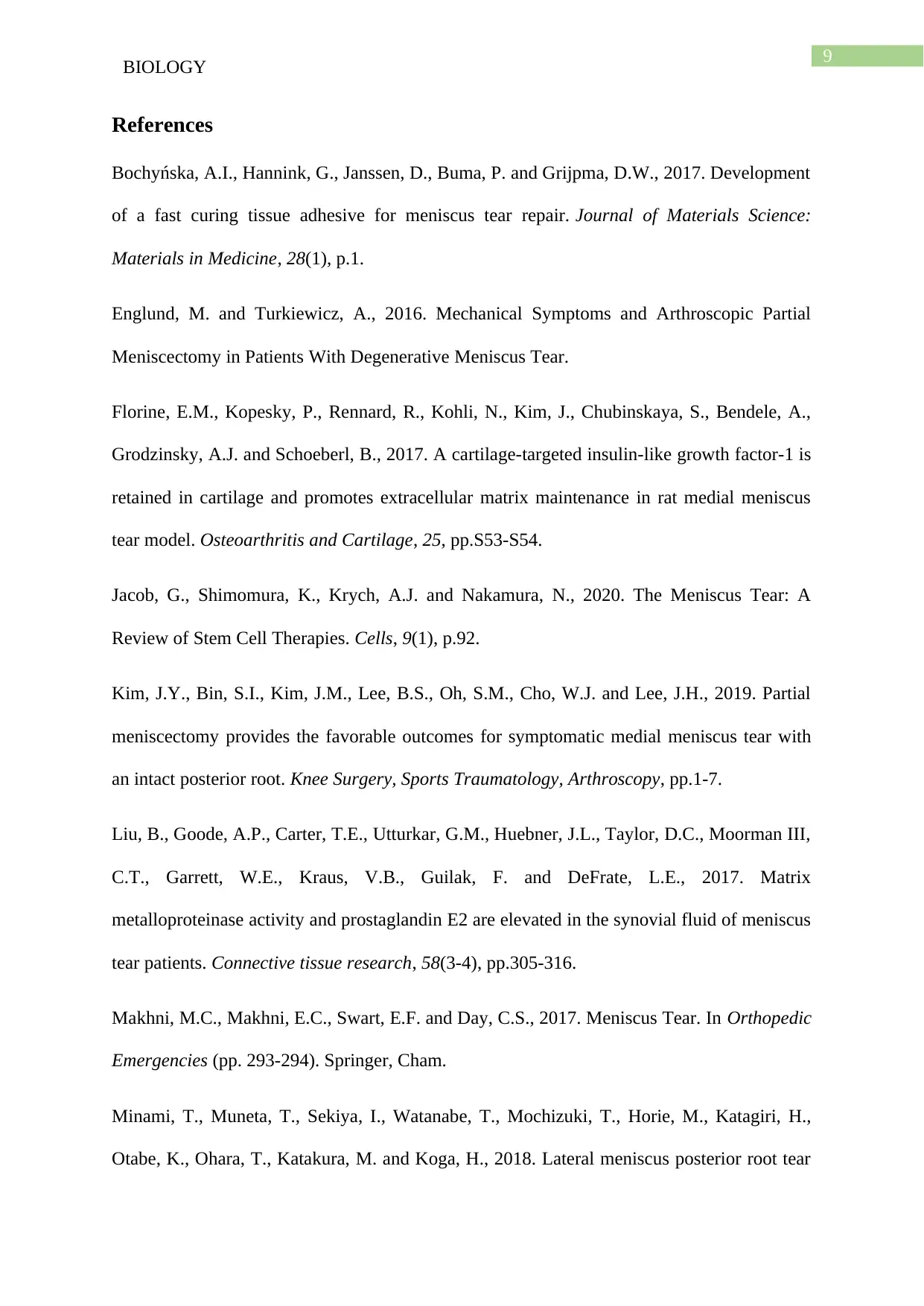
9
BIOLOGY
References
Bochyńska, A.I., Hannink, G., Janssen, D., Buma, P. and Grijpma, D.W., 2017. Development
of a fast curing tissue adhesive for meniscus tear repair. Journal of Materials Science:
Materials in Medicine, 28(1), p.1.
Englund, M. and Turkiewicz, A., 2016. Mechanical Symptoms and Arthroscopic Partial
Meniscectomy in Patients With Degenerative Meniscus Tear.
Florine, E.M., Kopesky, P., Rennard, R., Kohli, N., Kim, J., Chubinskaya, S., Bendele, A.,
Grodzinsky, A.J. and Schoeberl, B., 2017. A cartilage-targeted insulin-like growth factor-1 is
retained in cartilage and promotes extracellular matrix maintenance in rat medial meniscus
tear model. Osteoarthritis and Cartilage, 25, pp.S53-S54.
Jacob, G., Shimomura, K., Krych, A.J. and Nakamura, N., 2020. The Meniscus Tear: A
Review of Stem Cell Therapies. Cells, 9(1), p.92.
Kim, J.Y., Bin, S.I., Kim, J.M., Lee, B.S., Oh, S.M., Cho, W.J. and Lee, J.H., 2019. Partial
meniscectomy provides the favorable outcomes for symptomatic medial meniscus tear with
an intact posterior root. Knee Surgery, Sports Traumatology, Arthroscopy, pp.1-7.
Liu, B., Goode, A.P., Carter, T.E., Utturkar, G.M., Huebner, J.L., Taylor, D.C., Moorman III,
C.T., Garrett, W.E., Kraus, V.B., Guilak, F. and DeFrate, L.E., 2017. Matrix
metalloproteinase activity and prostaglandin E2 are elevated in the synovial fluid of meniscus
tear patients. Connective tissue research, 58(3-4), pp.305-316.
Makhni, M.C., Makhni, E.C., Swart, E.F. and Day, C.S., 2017. Meniscus Tear. In Orthopedic
Emergencies (pp. 293-294). Springer, Cham.
Minami, T., Muneta, T., Sekiya, I., Watanabe, T., Mochizuki, T., Horie, M., Katagiri, H.,
Otabe, K., Ohara, T., Katakura, M. and Koga, H., 2018. Lateral meniscus posterior root tear
BIOLOGY
References
Bochyńska, A.I., Hannink, G., Janssen, D., Buma, P. and Grijpma, D.W., 2017. Development
of a fast curing tissue adhesive for meniscus tear repair. Journal of Materials Science:
Materials in Medicine, 28(1), p.1.
Englund, M. and Turkiewicz, A., 2016. Mechanical Symptoms and Arthroscopic Partial
Meniscectomy in Patients With Degenerative Meniscus Tear.
Florine, E.M., Kopesky, P., Rennard, R., Kohli, N., Kim, J., Chubinskaya, S., Bendele, A.,
Grodzinsky, A.J. and Schoeberl, B., 2017. A cartilage-targeted insulin-like growth factor-1 is
retained in cartilage and promotes extracellular matrix maintenance in rat medial meniscus
tear model. Osteoarthritis and Cartilage, 25, pp.S53-S54.
Jacob, G., Shimomura, K., Krych, A.J. and Nakamura, N., 2020. The Meniscus Tear: A
Review of Stem Cell Therapies. Cells, 9(1), p.92.
Kim, J.Y., Bin, S.I., Kim, J.M., Lee, B.S., Oh, S.M., Cho, W.J. and Lee, J.H., 2019. Partial
meniscectomy provides the favorable outcomes for symptomatic medial meniscus tear with
an intact posterior root. Knee Surgery, Sports Traumatology, Arthroscopy, pp.1-7.
Liu, B., Goode, A.P., Carter, T.E., Utturkar, G.M., Huebner, J.L., Taylor, D.C., Moorman III,
C.T., Garrett, W.E., Kraus, V.B., Guilak, F. and DeFrate, L.E., 2017. Matrix
metalloproteinase activity and prostaglandin E2 are elevated in the synovial fluid of meniscus
tear patients. Connective tissue research, 58(3-4), pp.305-316.
Makhni, M.C., Makhni, E.C., Swart, E.F. and Day, C.S., 2017. Meniscus Tear. In Orthopedic
Emergencies (pp. 293-294). Springer, Cham.
Minami, T., Muneta, T., Sekiya, I., Watanabe, T., Mochizuki, T., Horie, M., Katagiri, H.,
Otabe, K., Ohara, T., Katakura, M. and Koga, H., 2018. Lateral meniscus posterior root tear
Paraphrase This Document
Need a fresh take? Get an instant paraphrase of this document with our AI Paraphraser
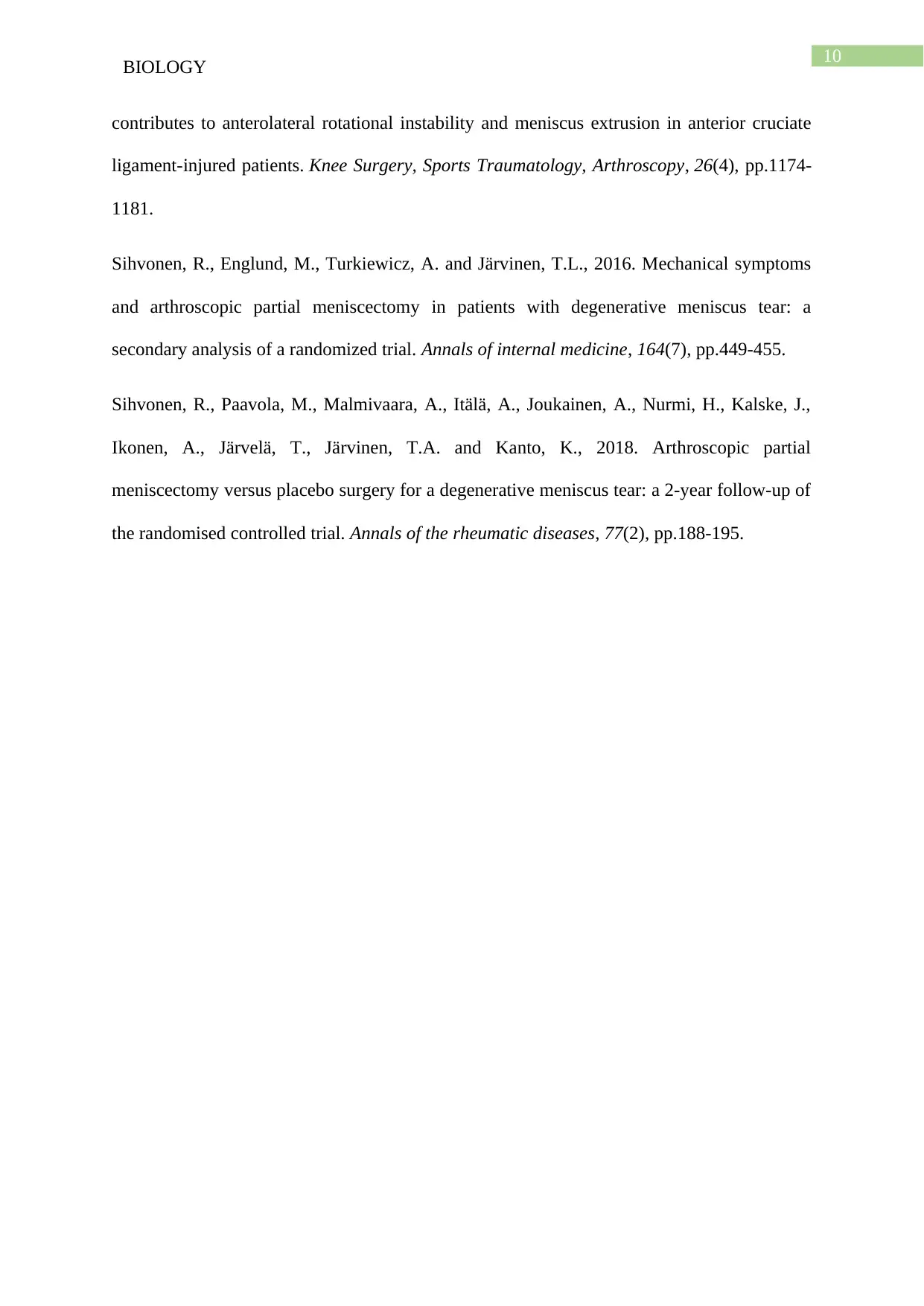
10
BIOLOGY
contributes to anterolateral rotational instability and meniscus extrusion in anterior cruciate
ligament-injured patients. Knee Surgery, Sports Traumatology, Arthroscopy, 26(4), pp.1174-
1181.
Sihvonen, R., Englund, M., Turkiewicz, A. and Järvinen, T.L., 2016. Mechanical symptoms
and arthroscopic partial meniscectomy in patients with degenerative meniscus tear: a
secondary analysis of a randomized trial. Annals of internal medicine, 164(7), pp.449-455.
Sihvonen, R., Paavola, M., Malmivaara, A., Itälä, A., Joukainen, A., Nurmi, H., Kalske, J.,
Ikonen, A., Järvelä, T., Järvinen, T.A. and Kanto, K., 2018. Arthroscopic partial
meniscectomy versus placebo surgery for a degenerative meniscus tear: a 2-year follow-up of
the randomised controlled trial. Annals of the rheumatic diseases, 77(2), pp.188-195.
BIOLOGY
contributes to anterolateral rotational instability and meniscus extrusion in anterior cruciate
ligament-injured patients. Knee Surgery, Sports Traumatology, Arthroscopy, 26(4), pp.1174-
1181.
Sihvonen, R., Englund, M., Turkiewicz, A. and Järvinen, T.L., 2016. Mechanical symptoms
and arthroscopic partial meniscectomy in patients with degenerative meniscus tear: a
secondary analysis of a randomized trial. Annals of internal medicine, 164(7), pp.449-455.
Sihvonen, R., Paavola, M., Malmivaara, A., Itälä, A., Joukainen, A., Nurmi, H., Kalske, J.,
Ikonen, A., Järvelä, T., Järvinen, T.A. and Kanto, K., 2018. Arthroscopic partial
meniscectomy versus placebo surgery for a degenerative meniscus tear: a 2-year follow-up of
the randomised controlled trial. Annals of the rheumatic diseases, 77(2), pp.188-195.
1 out of 11
Related Documents
Your All-in-One AI-Powered Toolkit for Academic Success.
+13062052269
info@desklib.com
Available 24*7 on WhatsApp / Email
![[object Object]](/_next/static/media/star-bottom.7253800d.svg)
Unlock your academic potential
Copyright © 2020–2025 A2Z Services. All Rights Reserved. Developed and managed by ZUCOL.




